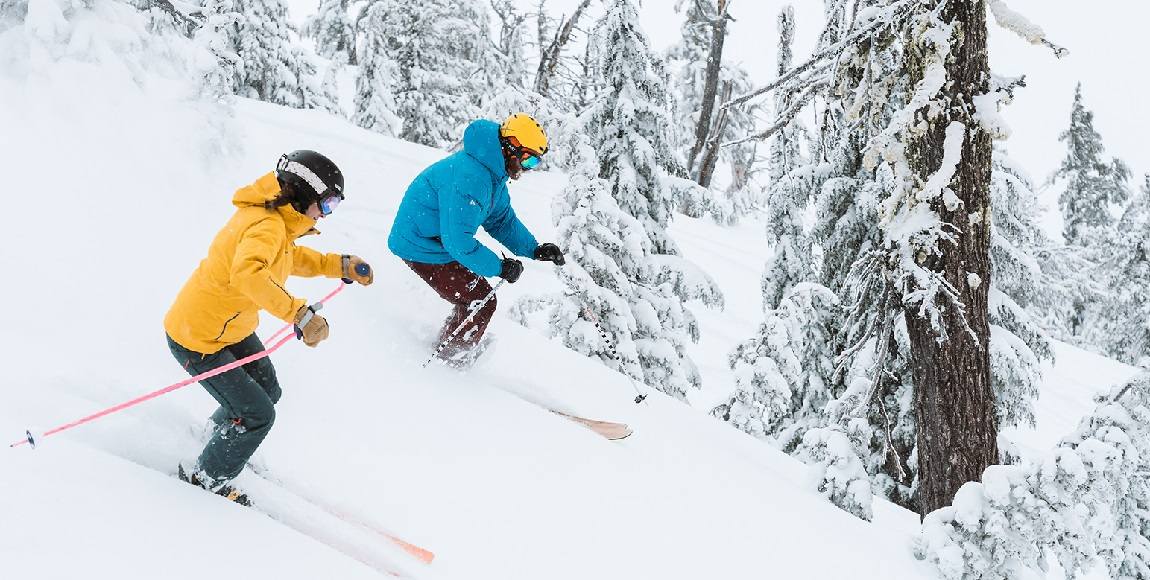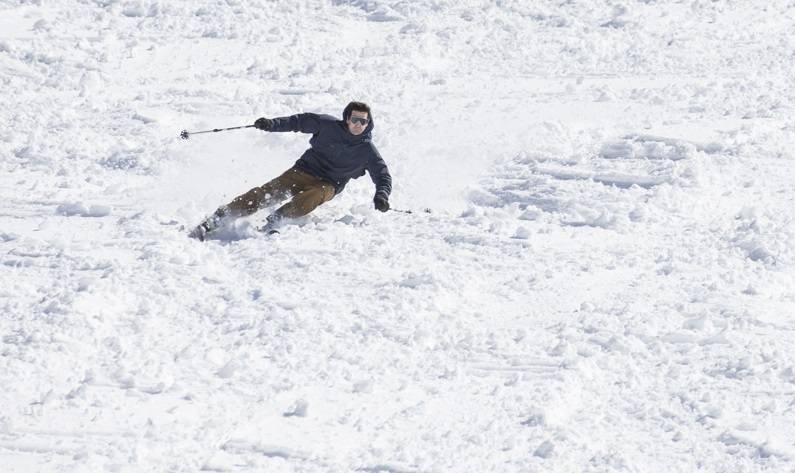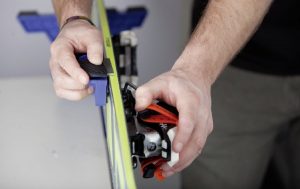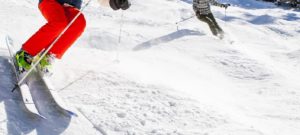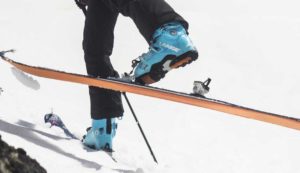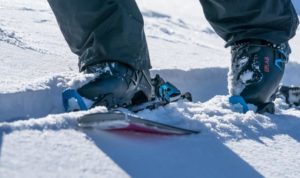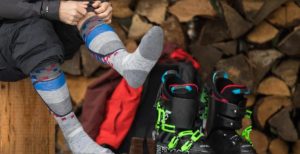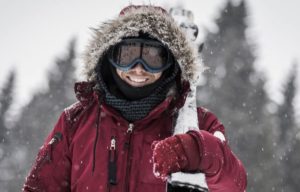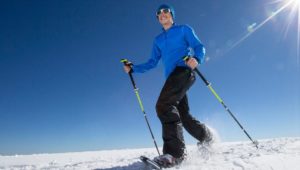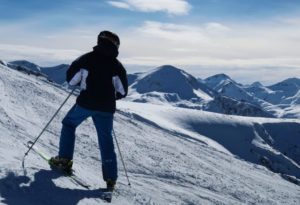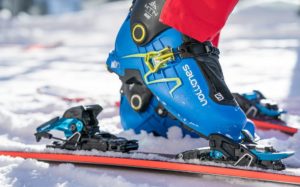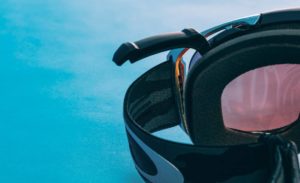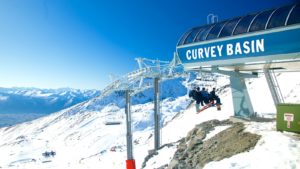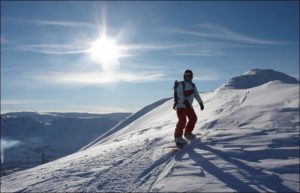What are the best backcountry touring skis?
To find out we put the most highly regarded products through an extensive multi-year test. We have selected 10 of them to present here. Over hundreds of thousands of vertical feet, we evaluated for touring efficiency and downhill enjoyment. We tested each product on different types of snow and with different riders. We considered safety, efficiency, and fun while assessing each product for weight, stability, and performance in different types of snow. In the end, we had clear winners and a handful of products that are excellent, but just a little edged out by the competition.
Resort skiing and backcountry skiing are different enough that reviews should reflect that.
Best Overall Backcountry Skis: Volkl V-Werks BMT 94
- 3D Ridge Carbon
- ICE OFF topsheet
- SkinPin
- Taper Shape
- Full Carbon Jacket
The Volkl is a mid-fat, mid-weight, high-performing ski machine. The Fischer Hannibal is the exact same width underfoot, lighter than the Volkl, but doesn’t ski as well. The Fischer is more fragile and a lot less expensive. With durability not reflected in our matrix (we did not do any destructive test to truly evaluate durability. Our assessment of durability is purely anecdotal) we used that distinguishing characteristic, plus a minimal overall advantage, to tip our top pick to the Volkl V-Werks BMT 94.
Also Great: Volkl VTA 98
A Volkl ski replaces a Volkl ski for our Editors Choice award. With the revamping of their BMT line, Volkl eliminated the 94mm version. This left a vacuum that the “just right” VTA 98 readily fills. It is wider than the BMT 94, but lighter, for a given length. The VTA skis everything better than any of the lighter skis we tested. It skis powder and breakable better even than the BMT 94. It’s one Achilles, at least in the long size we tested, is firm snow performance. We tested the longest VTA available and enjoyed it for stable, high-speed riding. For techier, steeper, and firmer skiing, we can extrapolate that a size down would better compete with the rest of the field. The VTA nails a weight “sweet spot”, at about 1450g per ski, that seems to be the point at which skis perform best without dramatically increasing the uphill demands. In even further good news, the VTA is quite a bit less expensive than the BMT ski was.
Best Value: Fischer Hannibal 94
- Paulownia Wood Core
- Sandwich Sidewall Construction
- Carbon-Stringers
- Tour Rocker
- Air Tec Ti
At a much lower price, granting the Best Value to the Fischer was an easy choice. The full reverse cambered construction, extensive use of carbon fiber, minimal sidecut, middle-of-the-road width, and Volkl’s secret sauce of engineering mystique combine to make a tool that is bouncy and fun in powder, solid on the firm, and predictable in poor snow. The skis are easy to ride, yet make the skier feel as though he or she is in charge.
How We Define Backcountry Skis
It is imperative that we clarify some terminology and usage. The equipment we reviewed is built for climbing up steep mountains and skiing back down them. We tested by doing exactly that. We climbed hundreds of thousands of vertical feet, usually on climbing skins with dedicated touring bindings and boots, and skied right back down. In this setting, whether in our testing or your ultimate application, both excellent and poor snow is encountered. Fatigue accumulates. We tested all the skis with modern, tech-style alpine touring bindings, boots, and technique.
The equipment we tested is not suited to flat or rolling terrain, though it is often pressed into duty there for approaches and exits. If you tour flat valley bottoms, lighter weight equipment is better. Mainly because of weight and durability compromises, we do not recommend most of the skis we tested here for extensive resort skiing. If you occasionally visit resorts for practice, backcountry access, or socializing, these skis can briefly suffice. However, if you ride long, hard days of lift-served skiing, you need proper alpine ski gear. Fortunately, most people have their resort gear first, and a backcountry setup as their second (or third, or fourth) set of skis.
Even within what we in the US call “backcountry skiing,” there are stylistic and preferential differences. It could be said that backcountry skiing encompasses all that happens outside of resort boundaries. Whether the skier reaches that terrain on skins, via technical climbing, on a ski lift, or inside a snowcat or helicopter, the snow conditions are similarly untamed. We tested skis for what the rest of the world calls “ski touring” with occasional forays into, and references to, “ski mountaineering.” Ski touring is the subset of backcountry skiing where one climbs the entirety of non-technical slopes under his or her own power, and skis back down.
How We Choose
Backcountry skiing is a fun and growing sport. Choosing equipment to enhance your experience is a daunting proposition. The right equipment is a joy to use and quickly becomes an extension of your body. Chosen poorly, backcountry specific skis are difficult, strenuous, and downright dangerous to the user. Our full review covers all you need to know to select the right skis for your pursuit.
Backcountry skis are getting better and better, but shopping for them is getting harder and harder. As the rising tide of skiers and ski technology lifts all manufacturers’ ships, products get closer and closer in performance.
Price
A comprehensive review of backcountry skis wouldn’t be complete without some discussion about price, or more specifically, the cost of performance. A good way to visualize this is by plotting retail price versus a performance metric, which is just what we’ve done here. In this case, the performance metric is an overall score, which takes many different attributes into account, so temper this by keeping in mind which are most important to you.
A little unusually, we have some high priced options here that didn’t score as well as others, such as the La Sportiva Vapor Nano, which is super light but lacks stability out of the powder. More often, the highest price tags come with scores to match. Our Editor’s choice award winner – the Volkl VTA 98 comes in at $699 and also happens to be tied for lowest priced ski we tested with our Best Buy – the Fischer Hannibal.
Firm Snow Performance
The Fischer is narrow and stiff, but ultralight. The Dynafit Cho Oyu is even more so. In the end, both perform pretty reliably on firm snow and inspire great confidence when it is steep and hard.
The wide and light skis like the DPS Tour1 and La Sportiva Nano exert great leverage without the mass and stiffness to back it up. These are best kept to slow speeds when the firm is encountered. All the skis in the middle of the weight and width spectrum, like the Volkl, Scott, and the Dynastar Mythic, do pretty well once the user is tuned into their quirks. The moderate width, but super damp constructed K2 Wayback is perhaps the least reliable of the mid-weights on firm snow. We found it to chatter and slip like one of the lightweight powder chasers. The wide, but heavy-ish K2 Coomback does surprisingly well on firm snow.
Crud/Poor Snow Performance
For ski touring and mountaineering, skis are differentiated by their weight, stability, firm snow performance, soft snow performance, and poor snow performance. Because backcountry skiers, on any given day, season, and lifetime, will inherently encounter variability and challenge, the ideal ski is a perfect balance of all these criteria. However, some criteria are competing. Heavier equipment is more stable, while lighter skis allow longer tours and faster travel.
Narrow profiles perform better on firm snow while fatter models are better in poor snow. All skis are amazing in perfect powder. Our team simulated typical patterns and preferences. We all like going downhill fast, in perfect powder snow, in spectacular settings. Everyone involved must understand, however, that physics and meteorology combine to temper that enthusiasm. Gravity makes lugging big equipment hard, and sun, wind, and drought make for tough snow conditions.
Besides weight, there are a couple of other considerations in the backcountry. If you will carry the skis in technical or brushy terrain, you might want to err on the shorter side. In the backcountry, you will ski a lot more untracked powder, sloppy “mash potatoes,” and breakable crust than in-bounds. When it is firm in the backcountry, it is often also super steep.

